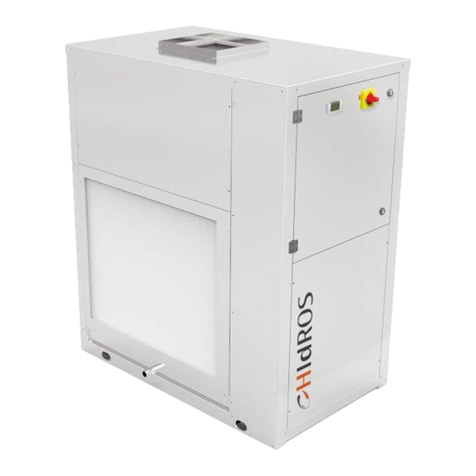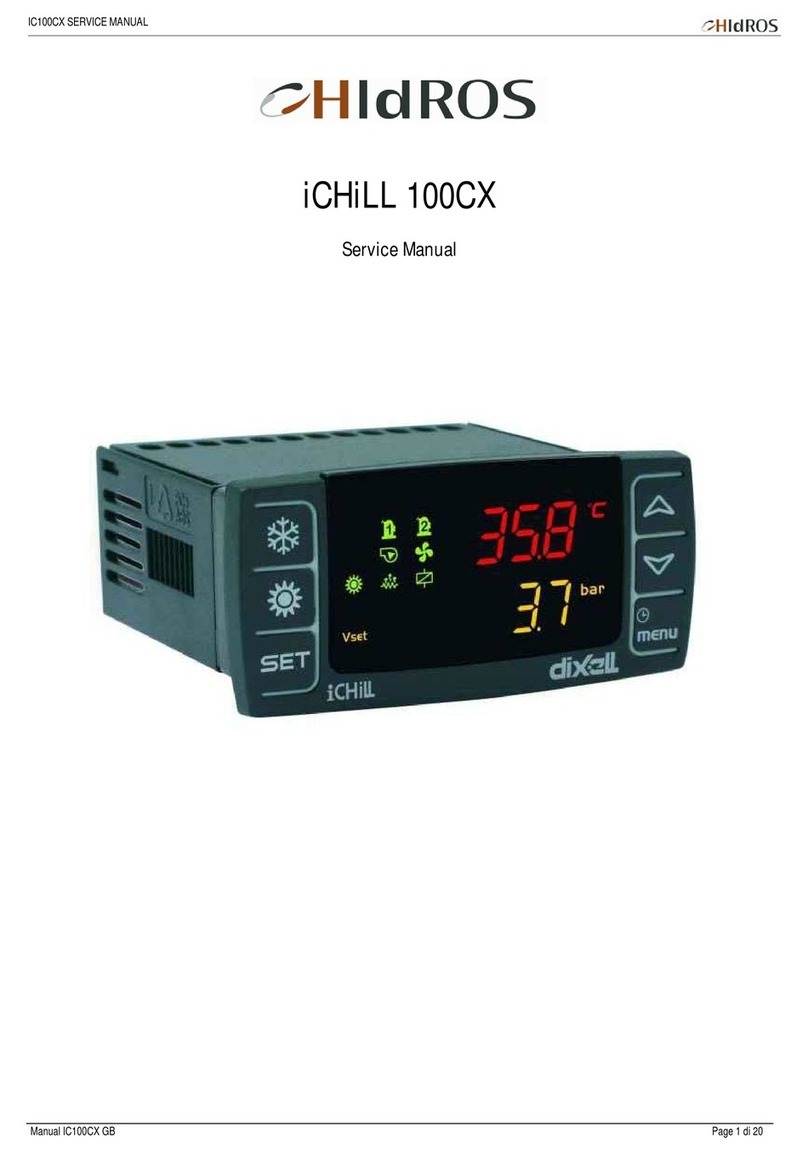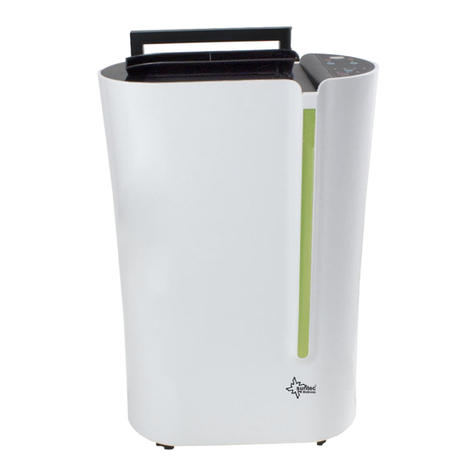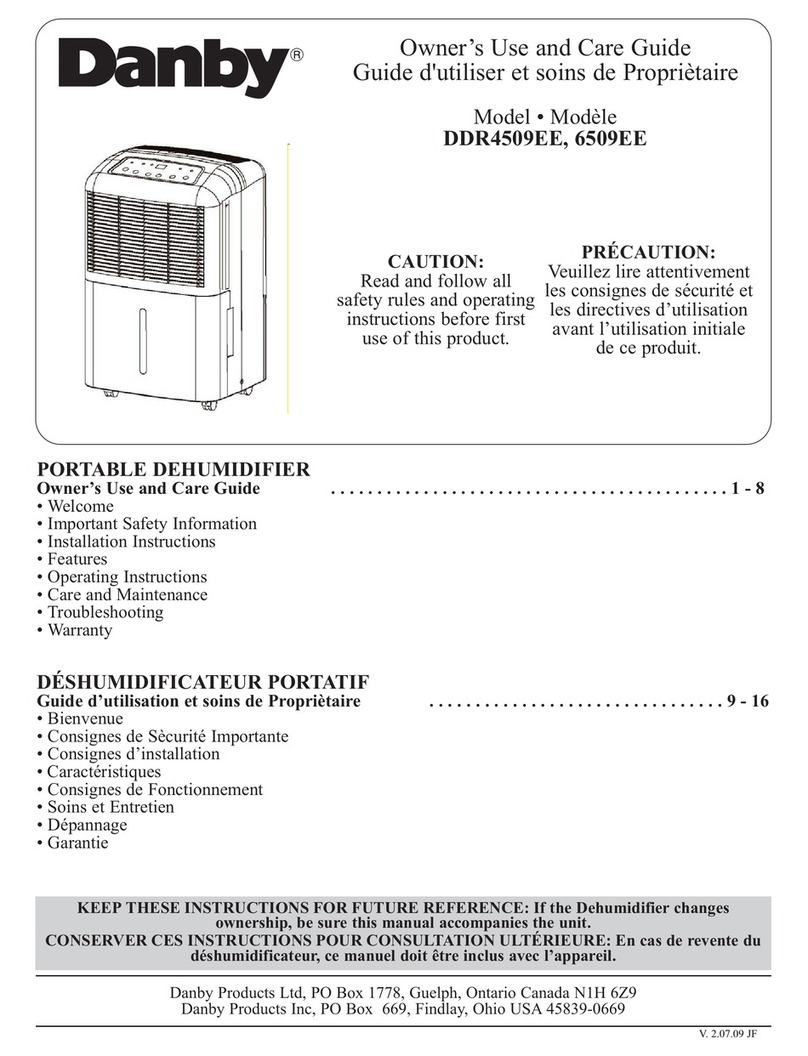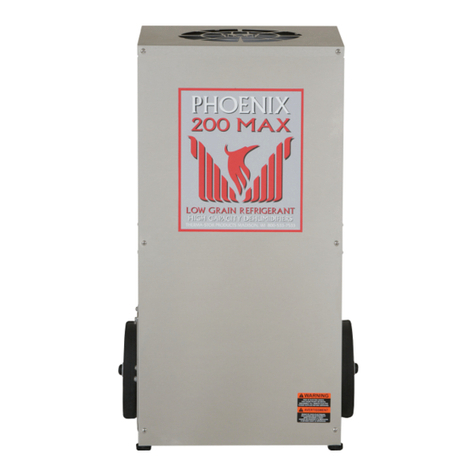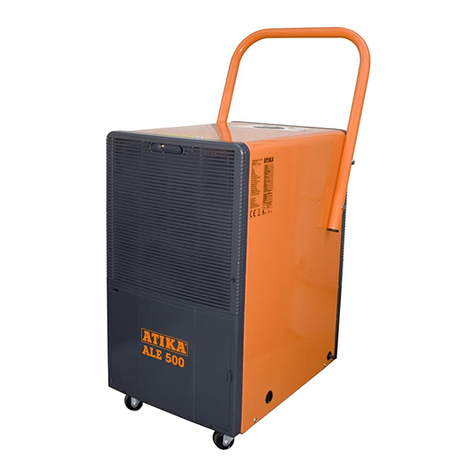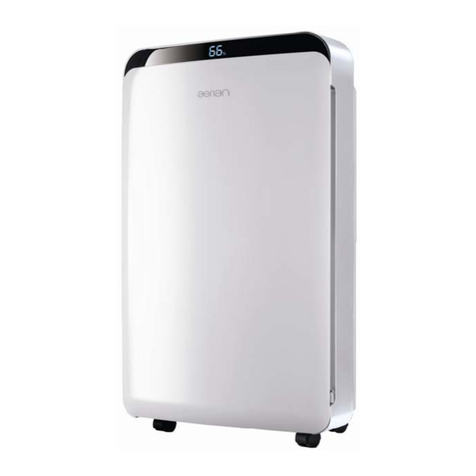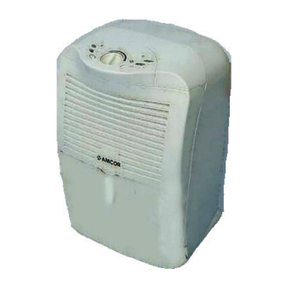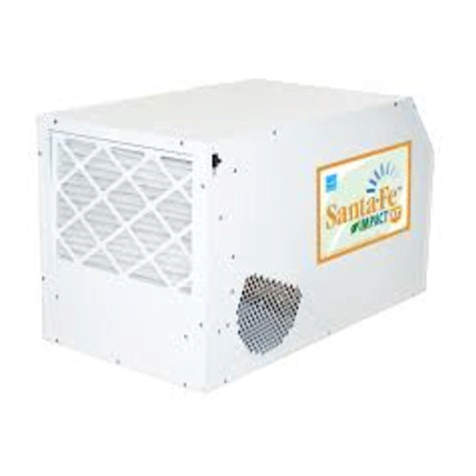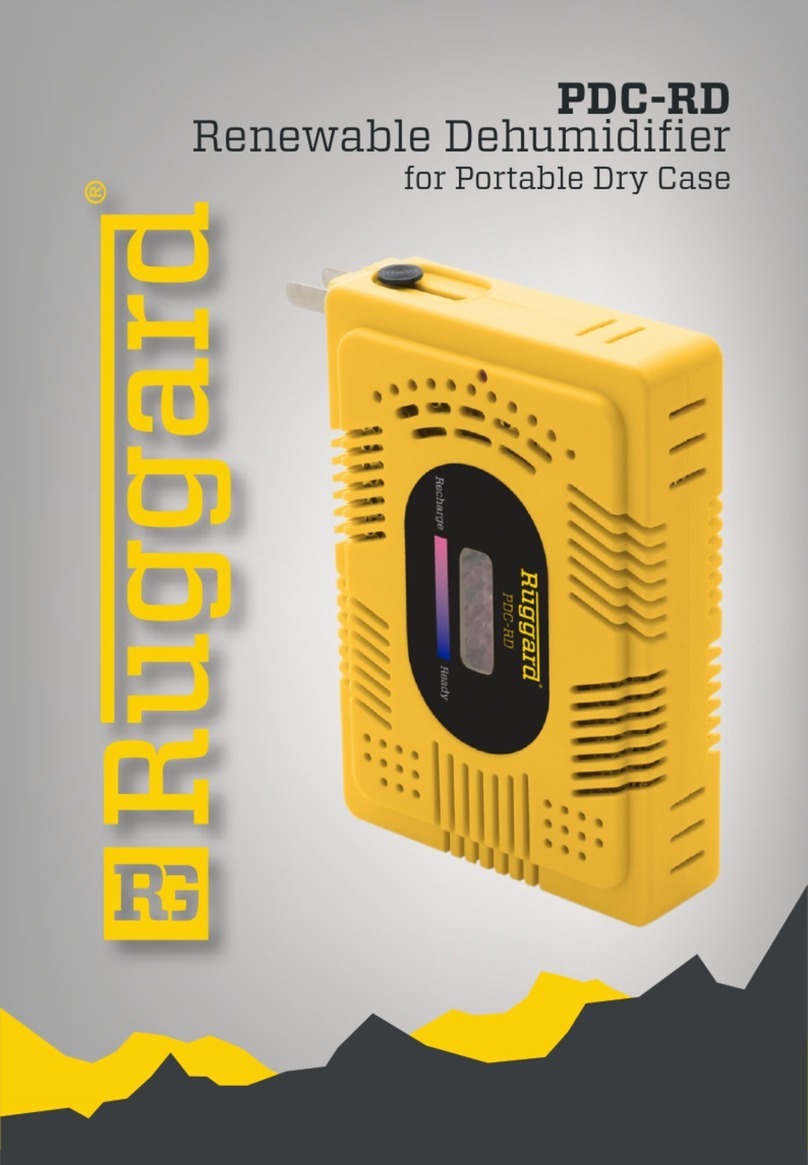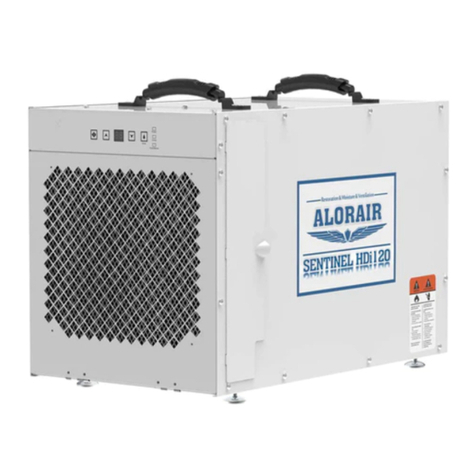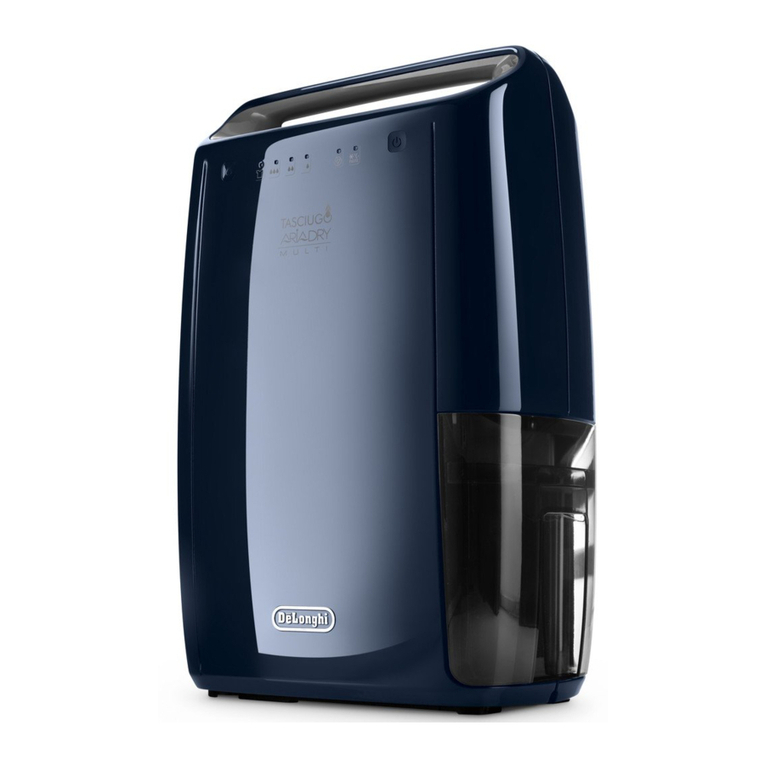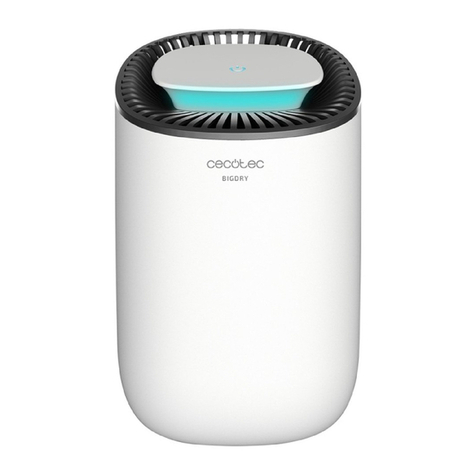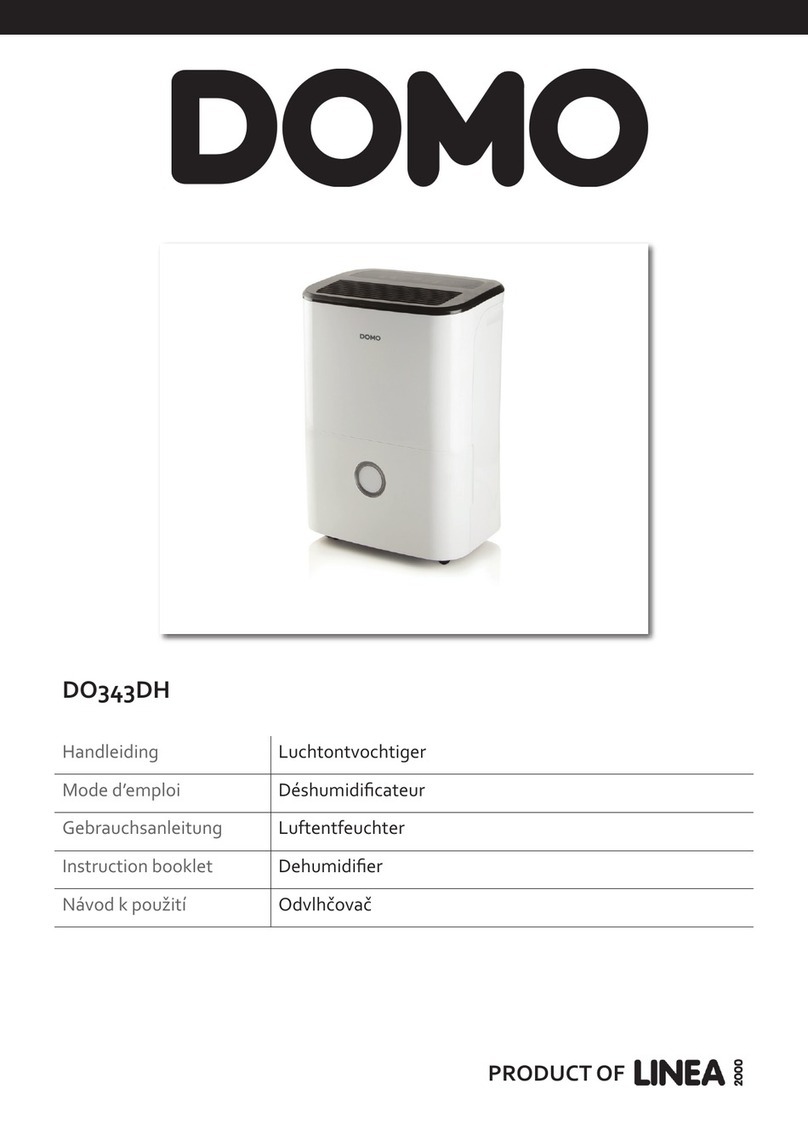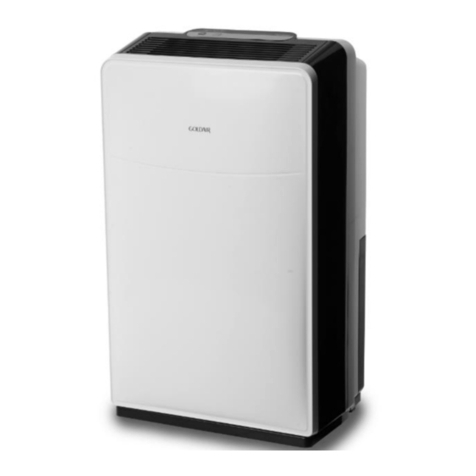HIdRos HHA Series User manual

INDUSTRIAL DEHUMIDIFIERS
HHA
SERIES
MTEC.5811.GB-F-1 Operation and maintenance manual HHA series English Rev. F 01-2022
Multiple instructions:
&RQVXOWWKHVSHFL¿FSDUW
Read and understand
the instructions before
undertaking any work on
the unit
RETAIN FOR FUTURE REFERENCE
Incorporated in this document are the following:
• Declaration of conformity
• Technical manual
• Dimensional drawing
TECHNICAL MANUAL
Original instructions

Rev. F 01-2022
2
MTEC.5811.GB-F-1 Operation and maintenance manual HHA series English
HHA,QGXVWULDOGHKXPLGL¿HUV
Reproduction, data storage and transmission, even partial, of this publication, in any form, without the prior written authorisation of the
Company, is prohibited. The Company can be contacted for all inquiries regarding the use of its products.
7KH &RPSDQ\ IROORZV D SROLF\ RI FRQWLQXRXV SURGXFW GHYHORSPHQW DQG LPSURYHPHQW DQG UHVHUYHV WKH ULJKW WR PRGLI\ VSHFL¿FDWLRQV
equipment and instructions regarding use and maintenance at any time, without notice.
Declaration of conformity
We declare under our own responsibility that the below equipment complies in all parts with the CEE and EN directives.
7KHGHFODUDWLRQRIFRQIRUPLW\LVHQFORVHGWRWKHWHFKQLFDOERRNOHWHQFORVHGZLWKWKHXQLW7KHXQLWFRQWDLQVÀXRULQDWHGJUHHQKRXVHJDVHV

Rev. F 01-2022
3
5
5
5
5
5
5
6
7
8
8
9
10
10
10
11
11
11
11
12
12
13
14
16
17
17
18
18
18
18
19
19
19
19
20
21
21
21
22
22
22
23
24
25
25
26
27
27
27
28
29
31
31
33
33
33
MTEC.5811.GB-F-1 Operation and maintenance manual HHA series English
HHA ,QGXVWULDOGHKXPLGL¿HUV
INDEX
1. INTRODUCTION.....................................................................................................................................................................................
1.1 Preliminary information......................................................................................................................................................
1.2 Aim and content of the manual ..........................................................................................................................................
1.3 How to store this manual ...................................................................................................................................................
1.4 Manual Update ..................................................................................................................................................................
1.5 How to use this manual .....................................................................................................................................................
1.6 Potential Risks...................................................................................................................................................................
1.7 General Description of Symbols Used...............................................................................................................................
1.8 Safety symbols used..........................................................................................................................................................
1.9 Limitations and prohibited use...........................................................................................................................................
8QLWLGHQWL¿FDWLRQ .............................................................................................................................................................
2. SAFETY .................................................................................................................................................................................................
2.1 Warning re potentially hazardous toxic substances...........................................................................................................
2.2 Refrigerant handling ..........................................................................................................................................................
2.3 Prevent inhalation of high vapor concentration..................................................................................................................
2.4 Procedures to be adopted in the event of accidental release of refrigerant ......................................................................
2.5 Main Toxicological Information Regarding the Type of refrigerant used ............................................................................
2.6 First Aid Measures .............................................................................................................................................................
3. TECHNICAL CHARACTERISTICS .........................................................................................................................................................
3.1 Unit description..................................................................................................................................................................
3.2 Accessories .......................................................................................................................................................................
3.3 Technical data....................................................................................................................................................................
3.4 Operation limits..................................................................................................................................................................
3.5 Sound data ........................................................................................................................................................................
3.6 Safety devices ...................................................................................................................................................................
4. INSTALLATION .......................................................................................................................................................................................
4.1 General safety guidelines and and use of symbols ...........................................................................................................
4.2 Health and safety Considerations .....................................................................................................................................
4.3 Personal protective equipment .........................................................................................................................................
4.4 Inspection .........................................................................................................................................................................
4.5 Storage ..............................................................................................................................................................................
4.6 Unpacking..........................................................................................................................................................................
4.7 Lifting and handling............................................................................................................................................................
4.8 Location and minimum technical clearances.....................................................................................................................
4.9 Condensate draining connections .....................................................................................................................................
4.10 How to vent the unit.........................................................................................................................................................
+RZWRUHPRYH¿OWHUV .......................................................................................................................................................
4.12 Installation of built-in room electronic sensor (RGDD).....................................................................................................
4.13 Serial interface card RS485 (INSE).................................................................................................................................
4.14 Connecting the unit to air duct channels..........................................................................................................................
4.15 Remote mechanical hygrostat installation (HYGR) .........................................................................................................
4.16 Electric connections: preliminary safety information........................................................................................................
4.17 Electrical data ..................................................................................................................................................................
4.18
How to connect the power supply....................................................................................................................................
4.19 Electric connections.........................................................................................................................................................
4.20 Refrigerant circuit layout..................................................................................................................................................
5. UNIT START UP......................................................................................................................................................................................
5.1 Preliminary checks.............................................................................................................................................................
5.2 Description of the control panel .........................................................................................................................................
5.3 Remote control panel.........................................................................................................................................................
6. USE .........................................................................................................................................................................................................
6.1 Switch the unit on ..............................................................................................................................................................
6.2 Stop ...................................................................................................................................................................................
6.3 Stand-by ............................................................................................................................................................................
6.4 How to change the set points ............................................................................................................................................

Rev. F 01-2022
4
34
34
34
35
35
36
36
36
38
39
39
39
39
.................................................................................................................................................................................................. 40
40
41
MTEC.5811.GB-F-1 Operation and maintenance manual HHA series English
HHA,QGXVWULDOGHKXPLGL¿HUV
6.5 Acoustic signal silencing ....................................................................................................................................................
6.6 Display during alarm..........................................................................................................................................................
6.7 Alarm reset.........................................................................................................................................................................
7. MAINTENANCE OF THE UNIT...............................................................................................................................................................
7.1 General warnings...............................................................................................................................................................
7.2 Drive access ......................................................................................................................................................................
7.3 Scheduled maintenance ....................................................................................................................................................
7.4 Periodical checks...............................................................................................................................................................
7.5 Refrigerant circuit repair ....................................................................................................................................................
8. DECOMMISSIONING.............................................................................................................................................................................
8.1 Disconnect the unit ............................................................................................................................................................
8.2 Disposal, recovery and recycling.......................................................................................................................................
8.3 RAEE Directive (only UE)..................................................................................................................................................
9. DIAGNOSIS AND TROUBLESHOOTING ..............................................................................................................................................
)DXOW¿QGLQJ ......................................................................................................................................................................
10. DIMENSIONAL DRAWINGS .................................................................................................................................................................

Rev. F 01-2022
5
MTEC.5811.GB-F-1 Operation and maintenance manual HHA series English
HHA ,QGXVWULDOGHKXPLGL¿HUV
1. INTRODUCTION
1.1 Preliminary information
1.2 Aim and content of the manual
1.3 How to store this manual
1.4 Manual Update
1.5 How to use this manual
Reproduction, storage or transmission of any part of this publication in any form, without the prior written consent of the Company, is pro-
hibited.
The unit to which these instructions refer, is designed to be used for the the purposes described and to be operated in accordance with
these instructions.
The Company will not be liable for claims for damage caused to persons, animals, material goods or property caused by improper installa-
WLRQDGMXVWPHQWDQGPDLQWHQDQFHRULPSURSHUXVH$Q\XVHQRWVSHFL¿HGLQWKLVPDQXDOLVSURKLELWHG
This document is intended to provide information only and does not form a contract with third parties.
The Company pursues a policy of constant improvement and development of its products and therefore reserves the right to change the
VSHFL¿FDWLRQVDQGWKHGRFXPHQWDWLRQDWDQ\WLPHZLWKRXWQRWLFHDQGZLWKRXWREOLJDWLRQWRXSGDWHH[LVWLQJHTXLSPHQW
These instructions are intended to provide the information required for the selection, installation, use and maintenance of the unit.
They have been prepared in accordance with the European Union laws and with the technical standards in force at the date of issue of the
instructions.
The instructions contain all the necessary information to prevent any reasonably foreseeable misuse.
The manual must be kept in a suitable place with easy access for users and operators, protected from dust and damp.
The manual must always accompany the unit during the entire life cycle of the same and therefore must be transferred to any subsequent
user.
It is recommended that the manual is updated to the latest revision available.
If updates are sent to the customer they must be added to this manual.
The latest information regarding the use of its products is available by contacting the Company.
The manual is an integral part of the unit.
Users or operators must consult the manual before performing any operation and especially so when transporting, han-
dling, installating, maintaining, or dismantling the unit in order to eliminate uncertainty and reduce risk.
In these instructions symbols have been used (described in the following paragraphs) to draw the attention of operators
and users to the operations that have a higher risk and which must be performed safely.

Rev. F 01-2022
6
MTEC.5811.GB-F-1 Operation and maintenance manual HHA series English
HHA,QGXVWULDOGHKXPLGL¿HUV
1.6 Potential Risks
Whilst the unit has been designed to minimize any risk posed to the safety of people who will interact with it, it has not been technically
possible to eliminate completely the causes of risk. It is therefore necessary to refer to the requirements and symbolism below:
LOCATION OF
RISK
POTENTIAL
RISK METHOD OF INJURY PRECAUTIONS
Thermal heat
exchangers. Small stab wounds. Contact Avoid any contact,
use protective gloves.
Fan and fan grilles. Cuts, eye damage,
broken bones.
Insertion of sharp objects
through the grid while the
fans are operating.
Never put objects through the protection grilles.
Internal component:
compressors and
discharge pipes
Burns. Contact Avoid any contact, use protective gloves.
Internal component:
electric cables and
metallic parts
Electrocution,
severe burns.
Defect in the supply ca-
ble insulation, live metal-
lic parts.
Adequate protection of power cables, ensure
correct earthing of all metal parts.
External to unit:
unit enclosure
Poisoning,
severe burns.
Fire due to short circuit
or overheating of the
supply cable external to
unit.
Size cables and mains protection system in ac-
cordance with iee regulations.
Low pressure safety
valve.
Poisoning,
severe burns.
High evaporating pres-
sure causing a refgrig-
erant discharge during
maintenance.
Carefully check the evaporating pressure dur-
ing the maintenance operations. Use all personal
protective equipment required by the law. PPE
must also protect against gas leaks from the
safety valve. The outlet of these valves is di-
rected to avoid causing damage to persons or
goods.
High pressure safety
valve.
Poisoning,
severe burns,
hearing loss.
Activation of the high
pressure safety valve
with the refrigerant circuit
open.
If possible, do not open the refrigerant circuit
valve; carefuly check the condensing pressure;
use all the personal protective equipment re-
quired by law. PPE must also protect against gas
leaks from the safety valve. The outlet of these
valves is directed to avoid causing damage to
persons or goods.
Entire unit ([WHUQDO¿UH
Fire due to natural dis-
asters or combustions of
elements nearby unit
3URYLGHWKHQHFHVVDU\¿UH¿JKWLQJHTXLSPHQW
Entire unit
Explosion, injuries,
burns, poisoning,
folgoramento for natural
disasters or earthquake.
Breakages, failures due
to natural disasters or
earthquake
Plan the necessary precautions both electrical
(suitable differential magneto and electrical pro-
tection of the supply lines; greatest care during the
connections of the metal parts), and mechanical
(special anchors or seismic vibrations to prevent
breakages or accidental falls ).

Rev. F 01-2022
7
MTEC.5811.GB-F-1 Operation and maintenance manual HHA series English
HHA ,QGXVWULDOGHKXPLGL¿HUV
BANNED
A black symbol inside a red circle with a red diagonal indicates an action that should not be performed.
WARNING
A black graphic symbol added to a yellow triangle with black edges indicates danger.
ACTION REQUIRED
A white symbol inserted in a blue circle indicates an action that must be done to avoid a risk.
7KHJUDSKLFV\PERO³ZDUQLQJ´LVTXDOL¿HGZLWKDGGLWLRQDOVDIHW\LQIRUPDWLRQWH[WRURWKHUV\PEROV
Safety symbols combined in accordance with ISO 3864-2:
1.7 General Description of Symbols Used
Safety symbols combined in accordance with ISO 3864-2:

Rev. F 01-2022
8
MTEC.5811.GB-F-1 Operation and maintenance manual HHA series English
HHA,QGXVWULDOGHKXPLGL¿HUV
GENERAL RISK
Observe all signs placed next to the pictogram. The failure to follow directions may create a risk situation that may
be injurious to the user.
ELECTRICAL HAZARD
Observe all signs placed next to the pictogram.
The symbol indicates components of the unit and actions described in this manual that could create an electrical
hazard.
MOVING PARTS
The symbol indicates those moving parts of the unit that could create risk.
HOT SURFACES
The symbol indicates those components with high surface temperature that could create risks.
SHARP SURFACES
The symbol indicates components or parts that could cause stab wounds.
EARTH CONNECTION
7KHV\PEROLGHQWL¿HV(DUWKLQJFRQQHFWLRQSRLQWVLQWKHXQLW
READ AND UNDERSTAND THE INSTRUCTIONS
Read and understand the instructions of the machine before any operations.
RECOVER OR RECYCLE MATERIAL
1.8 Safety symbols used
The unit is not suitable for operations in environments:
• excessively dusty or potentially explosive atmospheres;
• where there are vibrations;
ZKHUHWKHUHDUHHOHFWURPDJQHWLF¿HOGV
• where there are aggressive atmospheres
The machine is designed and built exclusively for the uses described in “Limitations of use” of the technical manual.
Any other use is prohibited because it may pose a potential risk to the health of operators and users.
1.9 Limitations and prohibited use

Rev. F 01-2022
9
Manufacturer: PD322111
Contiene gas fluorurati ad effetto serra disciplinati dal protocollo di Kyoto
Contains fluorinated greenhouse gasses covered by the Kyoto protocol
1+
++$
.150A-2A
Modello
Model
123456
1 7/2017
R410A
0,9 Kg 1,88 ton
2 2088
230V-1ph-50Hz
FACSIMIL
CS
ACS
AC
SI
S
SIM
MILE
E
LE
MIL
F
1,88 ton1,88 ton
Hz
22 bar 42 bar
-30 °C
145 Kg
+130 °C -30 °C +130 °C
13.4 A 2.7 kW
Matricola
Serial number
Categoria PED
PED Category
Tipo refrigerante
Refrigerant type
Tensione-Fasi-Frequenza
Voltage-Phases-Frequency
LATO BASSA PRESSIONE
LOW PRESSURE SIDE
LATO ALTA PRESSIONE
HIGH PRESSURE SIDE
Gruppo fluido
Fluid group GWP
Carica refrigerante
Refrigerant charge
C1
C3
C2
Min Max Min Max
C4
F.L.A. (A) F.L.I. (kW)
PS
Temperatura di progetto
Design temperature
Peso a vuoto
Weight
Temperatura di progetto
Design temperature
CO2Equivalente
CO2Equivalente
Data di fabbricazione
Manifacture date
PS
Via E. Mattei, 20
35028 Piove di Sacco PD - Italy
+39 049 9731022
www.hidros.eu
MTEC.5811.GB-F-1 Operation and maintenance manual HHA series English
HHA ,QGXVWULDOGHKXPLGL¿HUV
The product label should never be removed from the unit.
8QLWLGHQWLÀFDWLRQ
Each unit has a rating plate that provides key information regarding the machine.
The rating plate may differ from the one shown below as the example is for a standard unit without accessories.
For all electrical information not provided on the label, refer to the wiring diagram.
A facsimile of the label is shown below:

Rev. F 01-2022
10
MTEC.5811.GB-F-1 Operation and maintenance manual HHA series English
HHA,QGXVWULDOGHKXPLGL¿HUV
,GHQWLÀFDWLRQRIWKH7\SHRI5HIULJHUDQW)OXLG8VHG5$
'LÀXRURPHWKDQH+)&E\ZHLJKW&$61R
3HQWDÀXRURHWKDQH+)&E\ZHLJKW&$61R
2.1.6 Professional exposure limits
R410A
HFC-32 TWA 1000 ppm
HFC-125 TWA 1000 ppm
:DUQLQJUHSRWHQWLDOO\KD]DUGRXVWR[LFVXEVWDQFHV
2. SAFETY
For further information regarding the characteristics of the refrigerant and oil used, refer to the safety data sheets
available from the refrigerant and oil manufacturers.
,GHQWLÀFDWLRQRIWKH7\SHRI2LO8VHG
The lubricant used is polyester oil. Please refer to the information provided on the compressor data plate.
(19,5210(17$/3527(&7,21Read the ecological information and the following instructions carefully.
Main Ecological Information Regarding the Types of refrigerants Fluids used.
3HUVLVWHQFHDQGGHJUDGDWLRQ
(IIHFWVRIGLVFKDUJHV
2.1.5 Exposure controls and personal protection
The refrigerants used decompose in the lower atmosphere (troposphere) relatively quickly. The decomposed products are highly dispersible
DQGWKHUHIRUHKDYHDYHU\ORZFRQFHQWUDWLRQ7KH\GRQRWLQÀXHQFHWKHSKRWRFKHPLFDOVPRJZKLFKLVQRWDPRQJWKH92&YRODWLOHRUJDQLF
compounds (as stipulated in the guidelines to the UNECE). The constituent refrigerants of R410A (R32, R125), do not damage the ozone
layer. These substances are regulated under the Montreal Protocol (revised 1992) and regulations EC no. 2037/200 of 29 June 2000.
Discharges into the atmosphere of this product does not cause a long-term contamination.
Wear protective clothing and gloves, protect your eyes and face
5HIULJHUDQWKDQGOLQJ
Users and maintenance personnel must be adequately informed about the possible risks of handling potentially
toxic substances. Failure to follow such instructions can cause damage to personnel or to the unit.
3UHYHQWLQKDODWLRQRIKLJKYDSRUFRQFHQWUDWLRQ
3URFHGXUHVWREHDGRSWHGLQWKHHYHQWRIDFFLGHQWDOUHOHDVHRIUHIULJHUDQW
Atmospheric concentrations of refrigerant must be minimized and kept to a level that is below the occupational exposure limit. Vapor is
heavier than air and can form dangerous concentrations near the ground where the ventilation rate is lower. Always ensure adequate venti-
ODWLRQ$YRLGFRQWDFWZLWKRSHQÀDPHVDQGKRWVXUIDFHVDVWKLVFDQFDXVHWR[LFDQGLUULWDWLQJGHFRPSRVLWLRQSURGXFWVWRIRUP$YRLGFRQWDFW
between liquid refrigerant and the eyes or skin.
Ensure suitable personal protection (especially respiratory protection) during cleaning operations.
If deemed safe, isolate the source of the leak. If the leakage is small and if adequate ventilation is provided, allow the refrigerant to evapo-
rate. If the loss is substantial ensure that measures are taken to adequately ventilate the area.
Contain spilled material with sand, earth or other suitable absorbent material.
Do not allow the refrigerant to enter drains, sewers or basements, as pockets of vapor can form.

Rev. F 01-2022
11
MTEC.5811.GB-F-1 Operation and maintenance manual HHA series English
HHA ,QGXVWULDOGHKXPLGL¿HUV
0DLQ7R[LFRORJLFDO,QIRUPDWLRQ5HJDUGLQJWKH7\SHRIUHIULJHUDQWXVHG
2.5.1 Inhalation
A high atmospheric concentration can cause anaesthetic effects with possible loss of consciousness. Prolonged exposure may lead to
irregular heartbeat and cause sudden death. Higher concentrations may cause asphyxia due to the reduced oxygen content in the atmo-
sphere.
2.5.2 Contact with skin
Splashes of nebulous liquid can produce frostbite. Probably not hazardous if absorbed trough the skin. Repeated or prolonged contact may
remove the skin’s natural oils, with consequent dryness, cracking and dermatitis.
2.5.3 Contact with eyes
Splashes of liquid may cause frostbite.
,QJHVWLRQ
While highly improbable, may produce frostbite.
2.6 First Aid Measures
2.6.1 Inhalation
2.6.2 Contact with skin
Move the person away from the source of exposure, keep him/her warm and let him/her rest. Administer oxygen if necessary. Attempt
DUWL¿FLDOUHVSLUDWLRQLIEUHDWKLQJKDVVWRSSHGRUVKRZVVLQJVRIVWRSSLQJ,IWKHKHDUWVWRSVSHUIRUPH[WHUQDOKHDUWPDVVDJH6HHNPHGLFDO
assistance.
In case of contact with skin, wash immediately with lukewarm water. Thaw tissue using water. Remove contaminated clothing. Clothing may
stick to the skin in case of frostbite. If irritation, swelling or blisters appear, seek medical assistance.
$GKHUHVFUXSXORXVO\WRWKHZDUQLQJVDQG¿UVWDLGSURFHGXUHVLQGLFDWHGEHORZ
2.6.3 Contact with eyes
,QJHVWLRQ
2.6.5 Further medical treatment
Rinse immediately using an eyewash or clean water, keeping eyelids open, for at least ten minutes. Seek medical assistance.
Do not induce vomiting. If the injured person is conscious, rinse his/her mouth with water and make him/her drink 200-300ml of water. Seek
immediate medical assistance.
Treat symptoms and carry out support therapy as indicated. Do not administer adrenaline or similar sympathomimetic drugs following
exposure, due to the risk of cardiac arrhythmia.

Rev. F 01-2022
12
MTEC.5811.GB-F-1 Operation and maintenance manual HHA series English
HHA,QGXVWULDOGHKXPLGL¿HUV
3.1 Unit description
The dehumidifers are high-performances units especially designed for industrial or commercial purposes where humidity level should be
controlled or water vapor condensation should be prevented. These units are particularly indicated for archives, ironing rooms, bookstores,
cheese factories, underground rooms, cellars and industrial sites where high humidity level is present. This series comprises 8 models
which cover a capacity range from 49 to 530 l/24h. The units are designed for easy maintenance and service, each part being readily ac-
cessible and, when required, easily replaceable thus reducing service and maintenance costs. The units from size 50 to 200 are supplied
with a solenoid valves set for the hot gas injection used to defrost the evaporator in case of severe working conditions.
3.1.1 Frame
All units are made from hot-galvanised thick sheet metal, painted with polyurethane powder enamel at 180°C to ensure the best resistance
against the atmospheric agents. The frame is self-supporting with removable panels. All screws and rivets are in stainless steel. The colour
of the units is RAL 9018.
5HIULJHUDQWFLUFXLW
The refrigerant gas used in these units is R410A. The refrigerant circuit is made by using international primary brands components and
according to ISO 97/23 concerning welding procedures.
7KHUHIULJHUDQWFLUFXLWLQFOXGHVVLJKWJODVV¿OWHUGULHUWKHUPDOH[SDQVLRQYDOYHZLWKH[WHUQDOHTXDOL]HU6FKUDGHUYDOYHVIRUPPDLQWHQDQFH
and control, pressure safety device (according to PED regulation).
3.1.3 Compressors
The compressors are rotative type, with thermal overload protection by a klixon embedded in the motor winding. The compressor is
mounted on rubber vibration dampers and it is supplied,standard, with sound-proof cover to reduce noise emission. The inspection is pos-
sible through the frontal panel of the unit that allows the maintenance of the compressor.
3.1.4 Condenser and evaporator
Condensers DQGHYDSRUDWRUVDUHPDGHRIFRSSHUSLSHVDQGDOXPLQLXP¿QV
All evaporators are painted with epoxy powders to prevent corrosion problem due to their use in aggressive environments. The diameter of
WKHFRSSHUSLSHVLV´DQGWKHWKLFNQHVVRIWKHDOXPLQLXP¿QVLVPP7KHWXEHVDUHPHFKDQLFDOO\H[SDQGHGLQWRWKHDOXPLQLXP¿QV
to improve the heat exchange factor. The geometry of these heat exchangers guarantees a low air side pressure drop and then the use of
low rotation (and low noise emission) fans.
All units are supplied, standard, with a stainless steel drip tray and all evaporators are supplied with a temperature sensor used as automatic
defrost probe.
3.1.5 Supply fan
The fans are made of galvanized steel, centrifugal type. It is statically and dynamically balanced and supplied.
The electric motors are directly connected to the fan; they are all at 3 speeds, with integrated therma protection. The protection class of the
motors is IP 54.
$LUÀOWHU
It iVPDGHRIV\QWKHWLF¿OWHULQJPHGLDXQGXODWHGW\SHZLWKRXWHOHFWURVWDWLFFKDUJHWKH\DUHDOOUHPRYDEOHIRUGLIIHUHQWLDOGLVSRVDO(I¿FLHQF\
class M5, according to EN 779:2012.
3.1.7 Microprocessors
All units are supplied standard with microprocessor controls. The microprocessor controls the following functions: regulation of the water
temperature, antifreeze protection, compressor timing, compressor automatic starting sequence, alarm reset, potential free contact for
remote general alarm, alarms and operation leds.
3.1.8 Electric enclosure
The electric switch board is made according to electromagnetic compatibility norms CEE 73/23 and 89/336. The accessibility to the board is
possible after removing the front panel of the unit and the OFF positioning of the main switch. The following components are also standard
installed: main switch, magnetic-thermal switches (as a protection fans and compressors), control circuit automatic breakers, compressor
contactors, fan contactors. The terminal board is supplied with voltage free contacts for remote ON-OFF and general alarm.
3.1.9 Control and protection devices
All units are supplied with the following control and protection devices: antifreeze protection sensor, high pressure switch with manual
3. TECHNICAL CHARACTERISTICS

Rev. F 01-2022
13
MTEC.5811.GB-F-1 Operation and maintenance manual HHA series English
HHA ,QGXVWULDOGHKXPLGL¿HUV
reset, low pressure switch with automatic reset, high pressure safety valve, compressor thermal overload protection, fans thermal overload
protection.
3.1.10 Test
All the units are fully assembled and wired at the factory, carefully evacuated and dried after leak tests under pressure and then charged
with refrigerant R410A. They are all fully operational tested before shipment. They all conforms to European Directives and are individually
marked with the CE label and provided with Conformity Declaration.
3.2 Accessories description
3.2.1 'HOLYHU\ÁDQJHIRUFKDQQHOFRQQHFWLRQ&$1$
3UHVVIROGHGUHFWDQJXODUÀDQJHIRUFRQQHFWLRQWRWKHGXFWVDQGLQVWDOOHGRQWKHIDQH[SXOVLRQPRXWK
5HPRWHPHFKDQLFDOK\JURVWDW+<*5
7REHLQVWDOOHGRQWKHZDOOLWLVVXSSOLHGZLWKDUHJXODWLRQNQREDQGZRUNLQJUDQJHIURPWRZLWKSUHFLVLRQRI
6HULDOLQWHUIDFHFDUG56,16(
This interface card enables the controller to comunicate with other devices using Modbus protocol.
/RXYHUNLWDQGFDVHIRUGXFWHGYHUVLRQ.*%+
$LUJULOOHGRXEOHURZDGMXVWDEOHEUXVKHGDOXPLQLXP¿QVHTXLSSHGIRUZDOOPRXQWLQJZLWKVXEIUDPH
/RZQRLVHYHUVLRQ/6
This version includes the complete acoustic insulation of the unit (compressor + heat exchangers vanes) with compressor jackets
and insulating material made with high density media and the interposition of heavy bitumen layer.
5HPRWHFRQWUROSDQHO3&5/
This panel can be mounted up to 50m (maximum) from the unit and replicates all of the control functions. It is connected using a twin cable
of 0.5 mm sq section.
(OHFWURQLFWHPSHUDWXUHDQGKXPLGLW\SUREH5*''
Built-in Electronic temperature and humidity probe.
(&6XSSO\IDQ9&(
The supply fan is a high performance centrifugal type, double inlet forward curved blades, directly coupled to the electric motor. The fan
wheel and the scroll are made from hot galvanised thick sheet metal, painted with polyurethane powders, to ensure the best resistance
DJDLQVWDJJUHVVLYHHQYLURQPHQWV7KHHOHFWULFPRWRULVDKLJKHI¿FLHQF\'&EUXVKOHVVW\SHZLWKH[WHUQDOURWRUWRJXDUDQWHHDQLGHDOFRROLQJ
of the windings and the absence of power lost due to pulleys and belt transmission. The fan is statically and dynamically balanced class 6,3
according to ISO1940. The electric motor has a separate electronic commuter (driver) and a speed modulation 0-10V, integrated PFC, burn
out thermal protection (in case of considerable reduction of the power supply), protection degree IP54, serial interface card with modbus
protocol RTU.

Rev. F 01-2022
14
HHA 50 75 100 150 200 300 440 500
l/24h 49 73 95 155 190 298,5 468,2 532,9
l/24h 39,0 56,7 77,4 118,3 146,7 211,0 332,4 391,0
l/24h 34,9 50,1 69,1 104,4 129,5 185,7 296,3 344,0
l/24h 25,6 35,4 50,7 75,7 92,5 143,0 233,9 251,0
kW 0,7 1,29 1,76 2,07 2,74 3,80 6,10 7,20
kW 0,9 2,0 2,2 2,7 3,4 6,4 9,7 11,0
A 4,0 9,0 10,0 13,4 17,0 8,3 12,0 14,1
A 19,0 27,0 40,0 46,0 65,0 51,0 69,8 76,8
m3/h 500 800 1000 1400 1650 3500 4200 4200
Pa 50÷150 50÷150 50÷150 50÷150 50÷150 150÷250 150÷250 150÷250
R410A R410A R410A R410A R410A R410A R410A R410A
2088 2088 2088 2088 2088 2088 2088 2088
kg 0,36 0,60 0,60 0,90 1,20 3,00 3,00 3,00
t 0,75 1,25 1,25 1,88 2,20 6,26 6,26 6,26
dB(A) 57,0 59,0 61,0 66,5 68,5 78,0 79,0 79,0
dB(A) 50,0 52,0 54,0 59,5 61,5 70,0 71,0 71,0
V/Ph/Hz 230/1/50 230/1/50 230/1/50 230/1/50 230/1/50 400/3/50 400/3/50 400/3/50
MTEC.5811.GB-F-1 Operation and maintenance manual HHA series English
HHA,QGXVWULDOGHKXPLGL¿HUV
Performances are calculated with low fan speed and are referred to the following conditions:
7HPSHUDWXUH&+XPLGLW\
(2) Sound power level calculated according to ISO 9614.
6RXQGSUHVVXUHOHYHOPHDVXUHGDWPWIURPWKHXQLWLQIUHH¿HOGFRQGLWLRQVDFFRUGLQJWR,62
3.3 Technical data
0RLVWXUHUHPRYHGDW&
0RLVWXUHUHPRYHGDW&
0RLVWXUHUHPRYHGDW&
0RLVWXUHUHPRYHGDW&
Nominal input power (1)
Maximum input power
Maximum input current
Peak current
Air Flow
Available static pressure
Refrigerant
Global warming potential (GWP)
Refrigerant charge
Equivalent CO2charge
Sound power (1)
Sound pressure (2)
Power supply
The refrigerant data may change without notice. It is therefore necessary to refer always to the silver label placed
on the unit.

Rev. F 01-2022
15
0
50
100
150
200
250
400 420 440 460 480 500 520 540 560 580 600
0
100
200
300
400
500
650 700 750 800 850 900 950
0
50
100
150
200
250
300
350
800 850 900 950 1000 1050 1100 1150 1200
0
50
100
150
200
250
300
1150 1200 1250 1300 1350 1400 1450 1500 1550 1600 1650
0
50
100
150
200
250
1300 1400 1500 1600 1700 1800 1900 2000
HHA 050
HHA 075
HHA 100
HHA 150
HHA 200
P3K
Nom.
Med.
Med.
Nom.
Nom.
Nom.
Nom.
Max.
Max.
Max.
Max.
Min.
Min.
P3K
P3K
P3K
P3K
3D
3D
3D
3D
3D
MTEC.5811.GB-F-1 Operation and maintenance manual HHA series English
HHA ,QGXVWULDOGHKXPLGL¿HUV
3.3.1 Fans

Rev. F 01-2022
16
1050 152025303540
40
1050
30
15 20 25 30 35 40
60
50
80
70
100
90
40
30
60
50
80
70
100
90
Mod. 50-75-100-150-200 Mod. 300-440-500
0,0
100,0
200,0
300,0
400,0
500,0
2900 3100 3300 3500 3700 3900 4100 4300
0,0
100,0
200,0
300,0
400,0
500,0
3200 3400 3600 3800 4000 4200 4400 4600 4800
HHA 300
HHA 440 - 500
P3K
P3K
Max.
Nom.
Min.
Nom.
3D
3D
MTEC.5811.GB-F-1 Operation and maintenance manual HHA series English
HHA,QGXVWULDOGHKXPLGL¿HUV
3.11 Operation limits
Units are designed to operates with hot water coil supply temperature variables from 55°C to 80°C
The units MUST be used within the operation limit indicated in the diagrams (see above). the warranty will be inva-
lidated if the units are used in ambient conditions outside the limits reported. If there is the necessity to operate in
GLIIHUHQWFRQGLWLRQVSOHDVHFRQWDFWRXUWHFKQLFDORI¿FH
5+
5RRPWHPSHUDWXUH&
The units are designed to operate within false ceiling and/or heated technical room. The units are NOT suitable for
outdoor installations and / or technical room w/o heat (attics, rooms communicating with the outside) as it may form
condensation on the walls and inside the unit cabinet causing damages.
The units are designed to work in clean ambients and with the standard characteristics of the ambient air.
It’s suitable not to install the unit in swimming pools or ambient with polluted and/or aggressive air.
Contact the Company in case of necessity.
5+
5RRPWHPSHUDWXUH&

Rev. F 01-2022
17
Modd.
Lw Lp
63 125 250 500 1K 2K 4K 8K dB G%$ G%$
dB dB dB dB dB dB dB dB
50 71,1 62,3 56,2 54,7 53,6 48,2 44,8 35,7 71,9 58,0 50,0
75 73,1 64,3 58,2 56,7 55,6 50,2 46,8 37,7 73,9 60,0 52,0
100 75,1 66,3 60,2 58,7 57,6 52,2 48,8 39,7 75,9 62,0 54,0
150 80,6 71,8 65,7 64,2 63,1 57,7 54,3 45,2 81,4 67,5 59,5
200 82,6 73,8 67,7 66,2 65,1 59,7 56,3 47,2 83,4 69,5 61,5
300 90,4 81,6 79,5 73,6 68,5 60,1 55,3 47,0 91,3 78,0 70,0
440 91,4 83,4 80,3 74,6 69,9 59,7 55,5 46,7 92,4 79,0 71,0
500 91,4 83,7 79,8 74,3 70,7 61,6 57,6 49,2 92,4 79,0 71,0
MTEC.5811.GB-F-1 Operation and maintenance manual HHA series English
HHA ,QGXVWULDOGHKXPLGL¿HUV
3.7 Sound data
Sound data
2FWDYHEDQG+]
Lw: Sound power level according to ISO 9614.
/S6RXQGSUHVVXUHOHYHOPHDVXUHGDWPWIURPWKHXQLWLQIUHH¿HOGFRQGLWLRQVGLUHFWLRQIDFWRU4 DFFRUGLQJWR,62
3.8 Safety devices
+LJKSUHVVXUHVZLWFK
The high pressure switch stops the unit when the discharge compressor pressure is higher than the set value. The restart is automatic, done
when the pressure is under the level set in the differential value.
3.8.2 Defrost probe
It’s a device which signals to the electronic control, the necessity to make the defrost cycle. Once the defrost cycle is activated, the defrost
probe determines also its conclusion.
'HIURVWLQJ
7KHIURVWRQWKHFRLOREVWUXFWVWKHDLUÀRZUHGXFHVWKHDYDLODEOHH[FKDQJHDUHDDQGFRQVHTXHQWO\WKHXQLWSHUIRUPDQFHVDQGFDQVHULRXVO\
damage the system. All the units are supplied, standard, with a control which defrost automatically the heat exchanger if necessary. This
control provides a temperature probe (defrost thermostat) on the unit evaporator. When the defrost cycle is required, the microprocessor
control (according to set parameters), activates a hot gas injection, while the fan remains in operation. At the end of the defrost cycle, there
is a timer delay to allow condensate water to clear from the coil.

Rev. F 01-2022
18
MTEC.5811.GB-F-1 Operation and maintenance manual HHA series English
HHA,QGXVWULDOGHKXPLGL¿HUV
4. INSTALLATION
Before undertaking any task the operator must be fully trained in the operation of the machines to be used and
their controls. They must also have read and be fully conversant with all operating instructions.
All maintenance must be performed by TRAINED personnel and be in accordance with all national and local regu-
lations.
The installation and maintenance of the unit must comply with the local regulations in force at the time of the installa-
tion.
Avoid contact and do not insert any objects into moving parts.
*HQHUDOVDIHW\JXLGHOLQHVDQGDQGXVHRIV\PEROV
When operating and maintaining the unit, use the following personal protective equipment listed below as required
by law.
Protective footwear.
Eye protection.
Protective gloves.
Respiratory protection.
Hearing protection.
4.2 Health and safety Considerations
4.3 Personal protective equipment
The workplace must be kept clean, tidy and free from objects that may prevent free movement. Appropriate ligh-
ting of the work place shall be provided to allow the operator to perform the required operations safely. Poor or too
strong lighting can cause risks.
Ensure that work places are always adequately ventilated and that respirators are working, in good condition and
comply fully with the requirements of the current regulations.

Rev. F 01-2022
19
MTEC.5811.GB-F-1 Operation and maintenance manual HHA series English
HHA ,QGXVWULDOGHKXPLGL¿HUV
Packaging could be dangerous for the operators.
The packaging materials should be seperated and sent for disposal or possible recycling to specialist waste
companies.
4.4 Inspection
:KHQLQVWDOOLQJRUVHUYLFLQJWKHXQLWLWLVQHFHVVDU\WRVWULFWO\IROORZWKHUXOHVUHSRUWHGRQWKLVPDQXDOWRFRQIRUPWRDOOWKHVSHFL¿FDWLRQV
of the labels on the unit, and to take any possible precautions of the case. Not observing the rules reported on this manual can create
dangerous situations. After receiving the unit, immediately check its integrity. The unit left the factory in perfect conditions; any eventual
damage must be questioned to the carrier and recorded on the Delivery Note before it is signed. The company must be informed, within
8 days, of the extent of the damage. The Customer should prepare a written statement of any severe damage.
Before accepting the unit check:
• The unit did not suffer any damage during transport;
• The delivered goods are conforming to what shown in the delivery note.
,Q&DVHRI'DPDJH
• List the damage on the delivery note
• Inform the Company of the extent of the damage within 8 days of receipt of the goods. After this time any claim will not be considered.
• A full written report is required for cases of severe damage.
6WRUDJH
Units should be stored under cover and ideally, should remain in their packaging. The tools that are supplied for opening the electrics box
should be formally transferred to the person responsible for the plant.
8QSDFNLQJ
It is advisable to leave packaged units during handling and remove it before the installation.
The packaging must be removed carefully to prevent any possible damage to the machine.
The materials constituting the packaging may be different in nature (wood, cardboard, nylon, etc.).
When unloading the unit, it is strongly recommended that sudden movements are avoided in order to protect the refrigerant circuit, copper
tubes or any other unit component. Units can be lifted by using a forklift or, alternatively, using belts. Take care that the method of lifting does
not damage the side panels or the cover. It is important to keep the unit horizontal at all time to avoid damage to the internal components.
/LIWLQJDQGKDQGOLQJ
4.5.1 Shipment
The shipment must be carried out by authorised carriers and the characteristics of the vehicle used must be such as to avoid damaging the
machinery transported/to be transported, neither during loading and unloading nor during transport. If the roads to be driven are irregular,
WKHYHKLFOHPXVWEH¿WWHGZLWKVSHFLDOVXVSHQVLRQVRULQWHUQDOZDOOVLQRUGHUQRWWRGDPDJHWKHXQLWGXULQJWKHVKLSPHQW
The maximum ambient temperature for storage/shipment is +45°C and the minimum is -20°C,

Rev. F 01-2022
20
4
3
9
5
7
6
500 mm
300 mm 300 mm
300 mm
300 mm
300 mm
300 mm
1
11
88
2
A
F
C
DB
E
Mod. A B C D E F
50 300 300 500 300 100 200
75 300 300 500 300 100 200
100 300 300 500 300 100 200
150 300 300 500 300 100 200
200 300 300 500 300 100 200
300 300 300 500 300 100 200
440 300 300 500 300 100 200
500 300 300 500 300 100 200
MTEC.5811.GB-F-1 Operation and maintenance manual HHA series English
HHA,QGXVWULDOGHKXPLGL¿HUV
4.8 Location and minimum technical clearances
The unit has to be installed such that maintenance and repair is possible. The warranty does not cover costs for the
provision of lifting apparatus, platforms or other lifting systems required to perform repairs during warranty period.
The installation site should be chosen in accordance with EN 378-1 and 378-3 standards. When choosing the
installation site, all risks caused by accidental refrigerant leakage should be taken into consideration.
/HJHQG
1. False ceiling and perimeter walls
2. Anti-vibrating joint
3. Master control board
4. Ventilator fan
5. Hydraulic connections
6. Condensate drain
6XFWLRQ¿OWHU
8. Falce ceiling with remouvable panels
9. Vent valve
&HLOLQJHRIDOVHFHLOLQJLQVWDOODWLRQ
This manual suits for next models
8
Table of contents
Other HIdRos Dehumidifier manuals
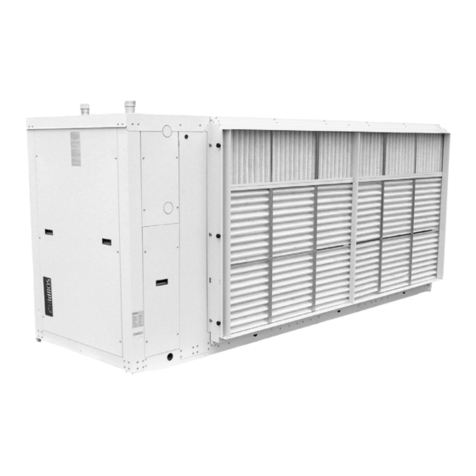
HIdRos
HIdRos SRH Series User manual
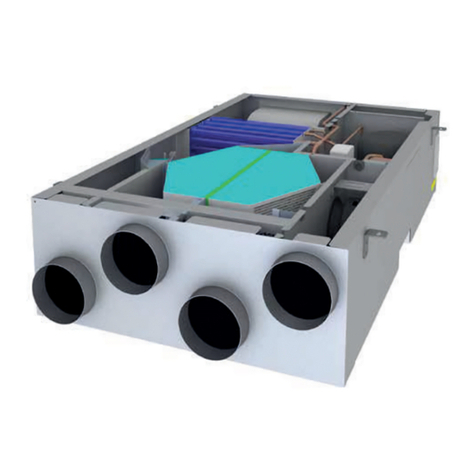
HIdRos
HIdRos GHE Series User manual
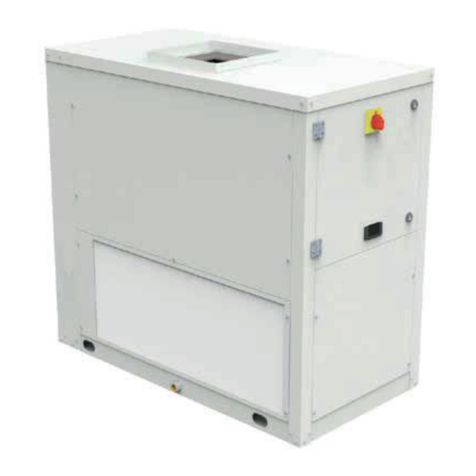
HIdRos
HIdRos HDA Series User manual

HIdRos
HIdRos HMA BT Series User manual

HIdRos
HIdRos SHH Series User manual
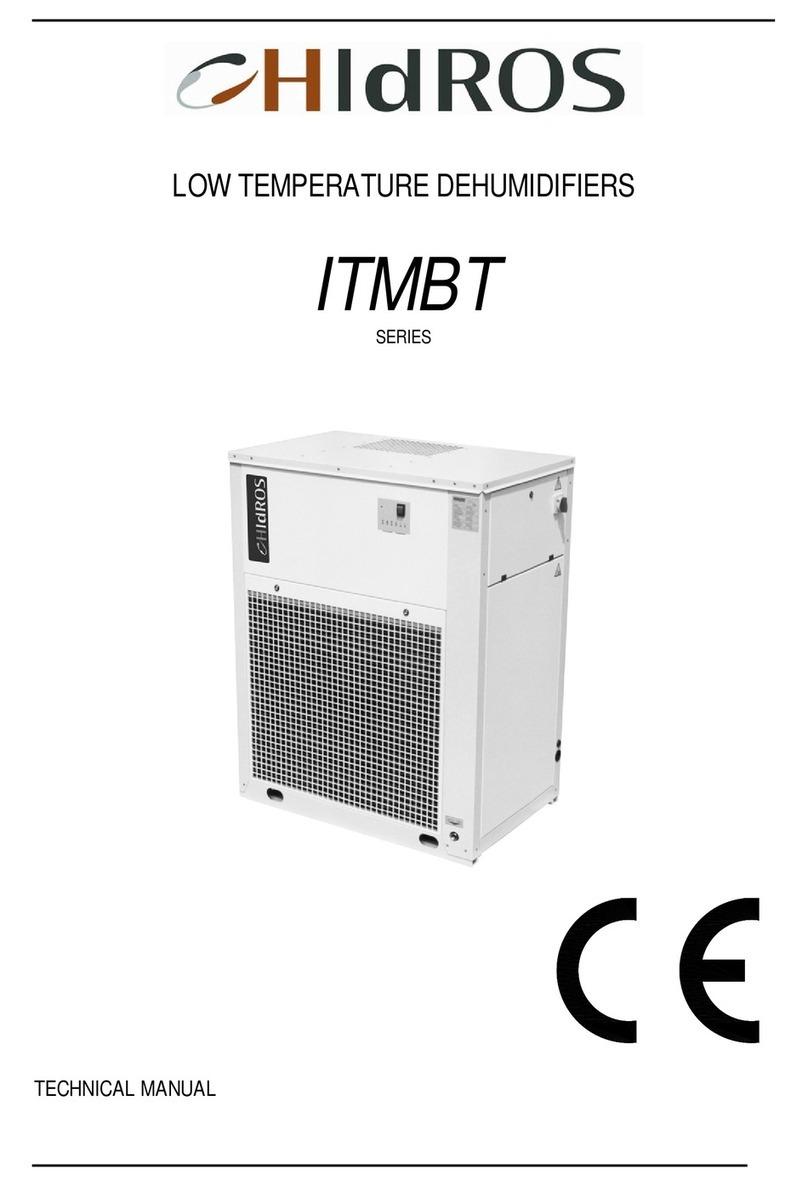
HIdRos
HIdRos ITMBT Series User manual
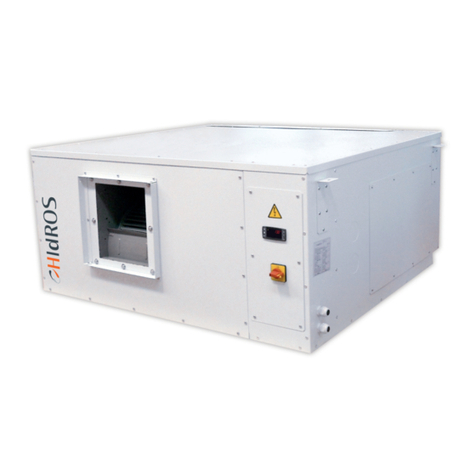
HIdRos
HIdRos SHA Series User manual
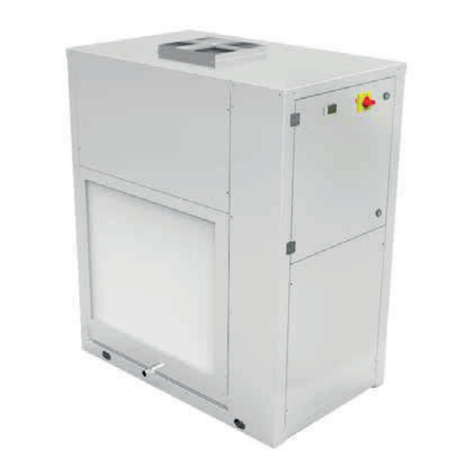
HIdRos
HIdRos SMA Series User manual
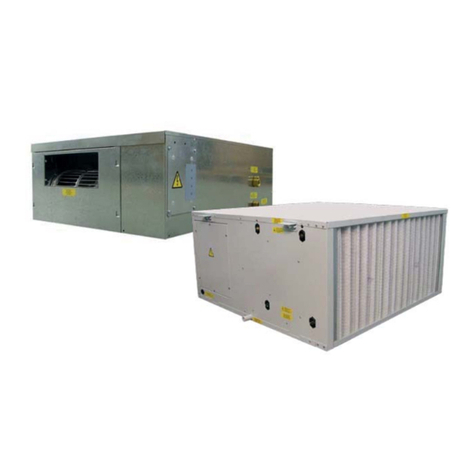
HIdRos
HIdRos GH Series User manual

HIdRos
HIdRos SDA Series User manual

